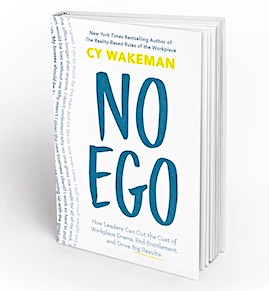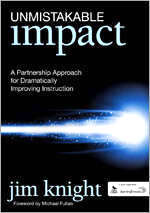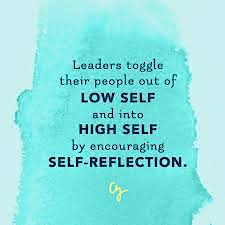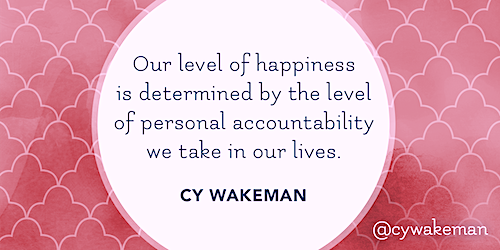 The video began something like this: “Hi, I’m Cy Wakeman and I’m a drama researcher.” That caught my attention. Drama researcher? What’s that? From her tone and from the fact that it was a video shared by Michael Bungay Stanier (author of The Coaching Habit and The Advice Trap), I concluded ‘drama researcher’ didn’t have anything to do with the theater!
The video began something like this: “Hi, I’m Cy Wakeman and I’m a drama researcher.” That caught my attention. Drama researcher? What’s that? From her tone and from the fact that it was a video shared by Michael Bungay Stanier (author of The Coaching Habit and The Advice Trap), I concluded ‘drama researcher’ didn’t have anything to do with the theater!
As the video continued, Wakeman noted that every day in an average workplace about 2.5 hours are devoted to some form of “drama” and what she labels as “emotional waste.” Each day? I wondered. Then I though back to the last time I worked for a large company and I could see her point. But 2-1/2 hours EVERY day???
I was hooked. I wanted to learn more and see if I could find connections to the education world. So I ordered Wakeman’s book, No Ego: How Leaders Can Cut the Cost of Workplace Drama, End Entitlement, and Drive Big Results (St. Martin’s Press, 2017).
What does “emotional waste” look like?
Wakeman defines emotional waste as “mentally wasteful thought processes or unproductive behavior that keeps leaders or their teams from delivering the highest level of results” (p. 16).
Examples include:
 Lack of ownership, accountability, commitment
Lack of ownership, accountability, commitment- Blaming circumstances or other people for lack of results
- Arguing with circumstances that were nonnegotiable
- Resistance to change
- Lack of buy-in to organizational strategies
- Spreading gossip
- Projecting (and believing) made-up stories instead of focusing on facts
- Defensiveness to feedback
- Dealing with hurt feelings
Sound familiar? Some of those actions seem to be in place at different times in almost every venue, including schools. I recalled a colleague referring to the drama as “domestic abuse” when referring to one particularly toxic school. Name-calling, siloes, and excuses were part of daily life there.
How do we address emotional waste?
Wakeman suggests addressing emotional waste through encouraging self-reflection – both internally and by helping the complainers reflect on the stories they are telling.” Ultimately, she says, “we can be operating out of our ego or out of our better self.”
She suggests some powerful reflection questions to help you get started. A few include:
- What did you do to help?
- What do you know for sure?
- What could you do next to add value?
- What would great look like?
I particularly like the question “What would great look like?” If I’m unhappy with a situation or circumstance, that particular question turns my thinking on its head. Instead of feeling helpless or victimized, I shift to thinking about not only how to solve the problem or issue, but how to make it shift from something potentially toxic to some that’s truly great for all involved.
Wakeman gives several examples of using the “great question” in her Tedx Talk. Be sure to watch the whole talk, which is about 16 minutes, where near the end she tells a personal powerful story to illustrate the kind of impact the What would great look like? reflection can have.
Ditch the Drama – How to Live Happy in a Messy World
Deemed “the secret weapon to restoring sanity to the workplace,” Cy Wakeman’s Reality-Based Leadership Philosophy has helped thousands of organizations like Facebook, Google, Pfizer, and National Institutes of Health learn to harness energy wasted in drama and reinvest that effort into achieving profound results and true employee engagement. (from the TedX description)
Some strategies seem harsh
Wakeman reminds the reader of her philosophy that buy-in is not optional, but rather a condition of employment. As I read that section of the book, I annotated the text this way: “Hmm…is she assuming it is an ethical decision and also not one made unilaterally?” I wondered how the partnership principles, to which I subscribe, applied.
I actually pulled out partnership coach Jim Knight’s Unmistakable Impact and turned to his definition of the partnership approach:
 At its core, the partnership approach is about a simple idea: treat others the way you would like to be treated…If someone was talking with you about your work, how would you like them to relate to you?
At its core, the partnership approach is about a simple idea: treat others the way you would like to be treated…If someone was talking with you about your work, how would you like them to relate to you?
Chances are you would want them to treat you as an equal, to respect your knowledge enough to let you make some decisions about how you do your work. You would probably want them to ask your opinion and listen to your voice, to talk with you in a way that encouraged thought and dialogue about your real-life experience.
If they also demonstrated that they expected to learn from you, it would probably make it all the more likely that you would listen to them (p. 28).
Cognitive dissonance set in as I read Jim’s collaborative approach to “buy-in.” I wondered whether Wakeman’s philosophy could align with partnership. I decided to keep reading.
In the same section, Wakeman suggests that leaders could not “purchase buy-in,” nor should they try (p. 149). The first step to gaining buy-in, according to Wakeman, is working with the willing. For those employees/colleagues who are still skeptical, she suggests asking: “On a scale of 1 to 10, what is your level of buy-in to this new strategy/change?” If the score is low, she suggests a follow-up question: “What is your plan to get bought in?” or “How could you use your expertise to mitigate the concerns you have to ensure buy-in and deliver results?”
Finally, for those unwilling, she suggests asking this question: “It sounds like buy-in isn’t something you’re willing to offer right now. What plans do you have to transition off this assignment or team?”
Okay, I thought, this might work, if posed in a dialogical way for colleagues not willing, let’s say, to participate in collaborative lesson planning, or a PLC. Certainly any action like this needs to be situational, mindful of the desired result and the process that led to identifying the result.
Remaining skeptical I reminded myself that Wakeman’s intended audience seemed to be leaders of large corporate organizations. Were there other take-aways for educators?
The other take-aways I found
 Wakeman’s emphasis on using self-reflection as a tool to minimize drama is a key take-away I can fully endorse. I like the four questions she recommended to prompt reflection, which I listed above. And, I really like the way she ended the book:
Wakeman’s emphasis on using self-reflection as a tool to minimize drama is a key take-away I can fully endorse. I like the four questions she recommended to prompt reflection, which I listed above. And, I really like the way she ended the book:
“Some of you may see this leadership approach as tough love. I like to express it a different way. Reality is tough. Leadership is love. As leaders assume their bold new role, one that moves people beyond ego and into endless possibilities, let me add a few gentle cautions:
- Check your own ego before you attempt to engage another’s.
- Be gentle. You want to wake people up, but not by violently shaking them up.
- Go slowly. Take great care as you disrupt thinking, spur self-reflection, and help people develop the capacity to move more skillfully into reality.
- Make the call to greatness. Work with those willing to answer that call.
- Don’t forget: human potential is limitless. A workplace characterized by consistent creativity, endless innovation, and readiness for what’s next is possible. Peace and happiness in the workplace are achievable. As emotional waste is eliminated, work becomes less effortful and more joyful. Use some of the recaptured energy to celebrate accomplishments and great results.
- Summon up all the compassion you can. We are human. Any of us, at any time, has the ability to move into ego. You will screw this up, but only every day. Forgive yourself. It’s a practice. Try again.
- Forgive others early and often. Don’t be afraid of the do-over. When you notice the times you could have been better, be transparent… (pp. 161-162)”
In the end, I do think there is value in Wakeman’s role as a drama researcher, and I believe it is possible to connect the partnership approach to Wakeman’s “no ego process.”
If done carefully – with positive intent and your eye on reflection, care, and love – this approach might just minimize the drama in a school or district. And when that happens, I hope you’ll follow Wakeman’s ending advice: “Use some of the recaptured energy to celebrate accomplishments and great results.”
ALSO SEE:


0 Comments on "How Can We Reduce ‘Workplace Drama’ to Increase Buy-In and Teamwork?"